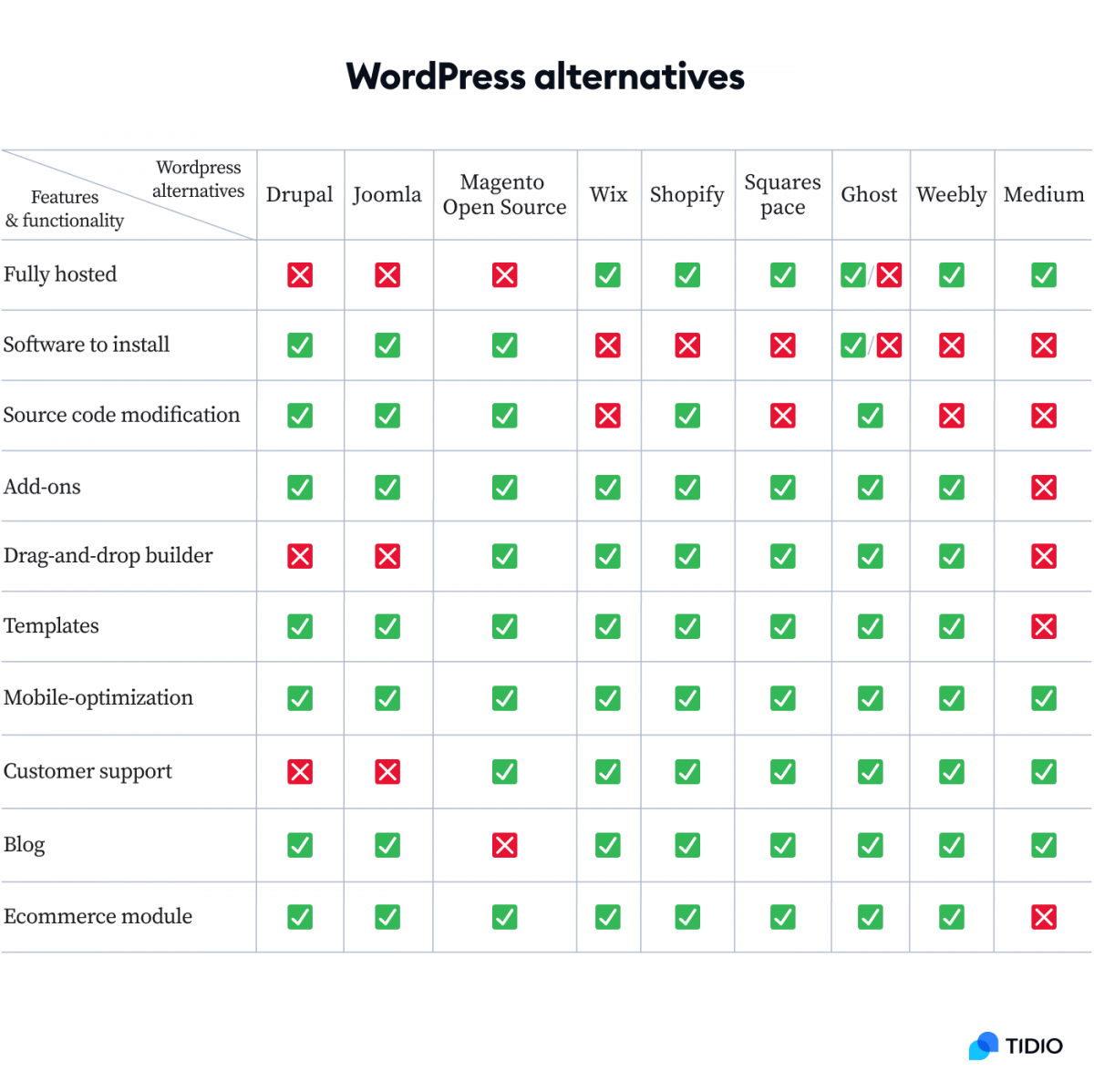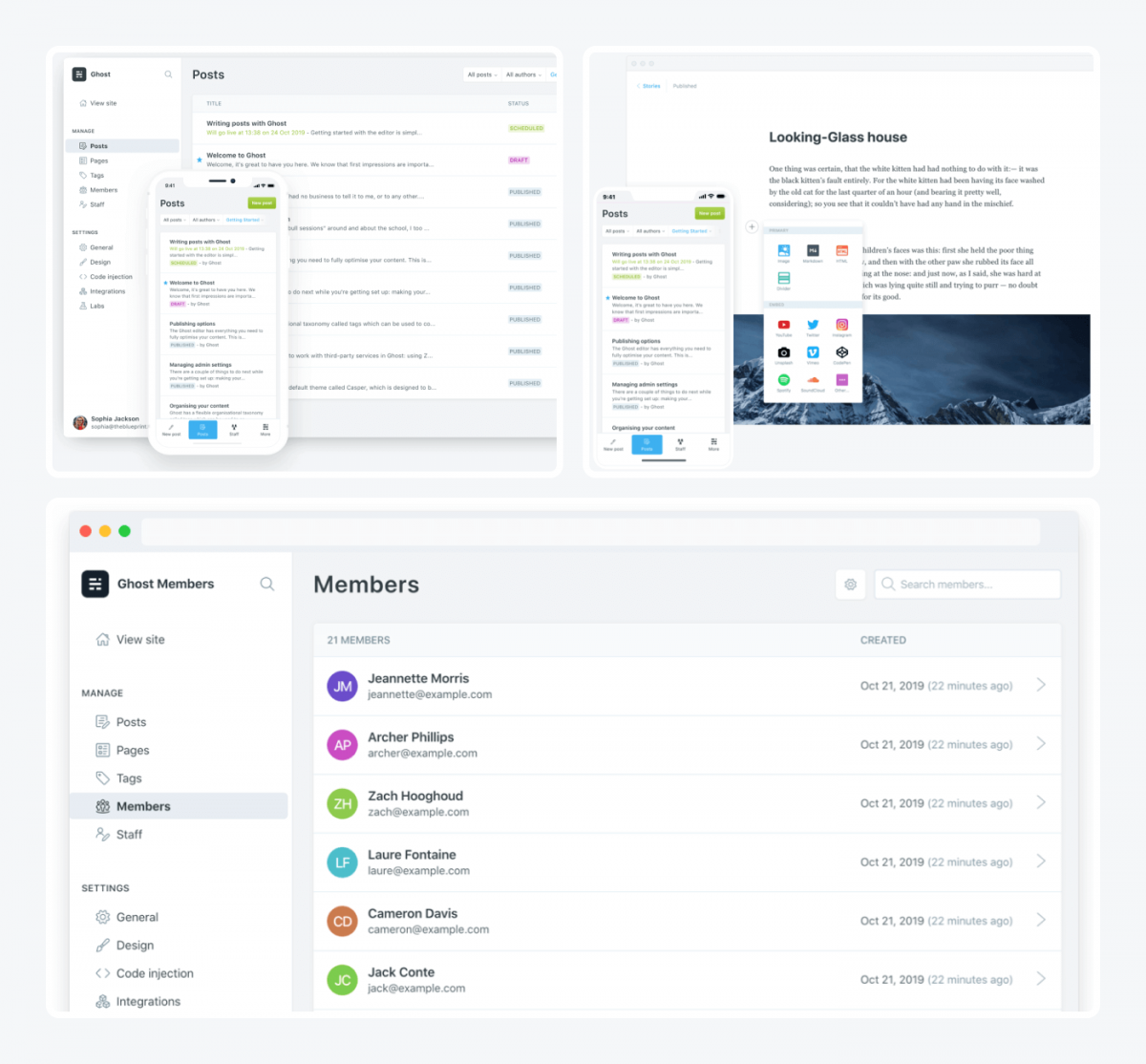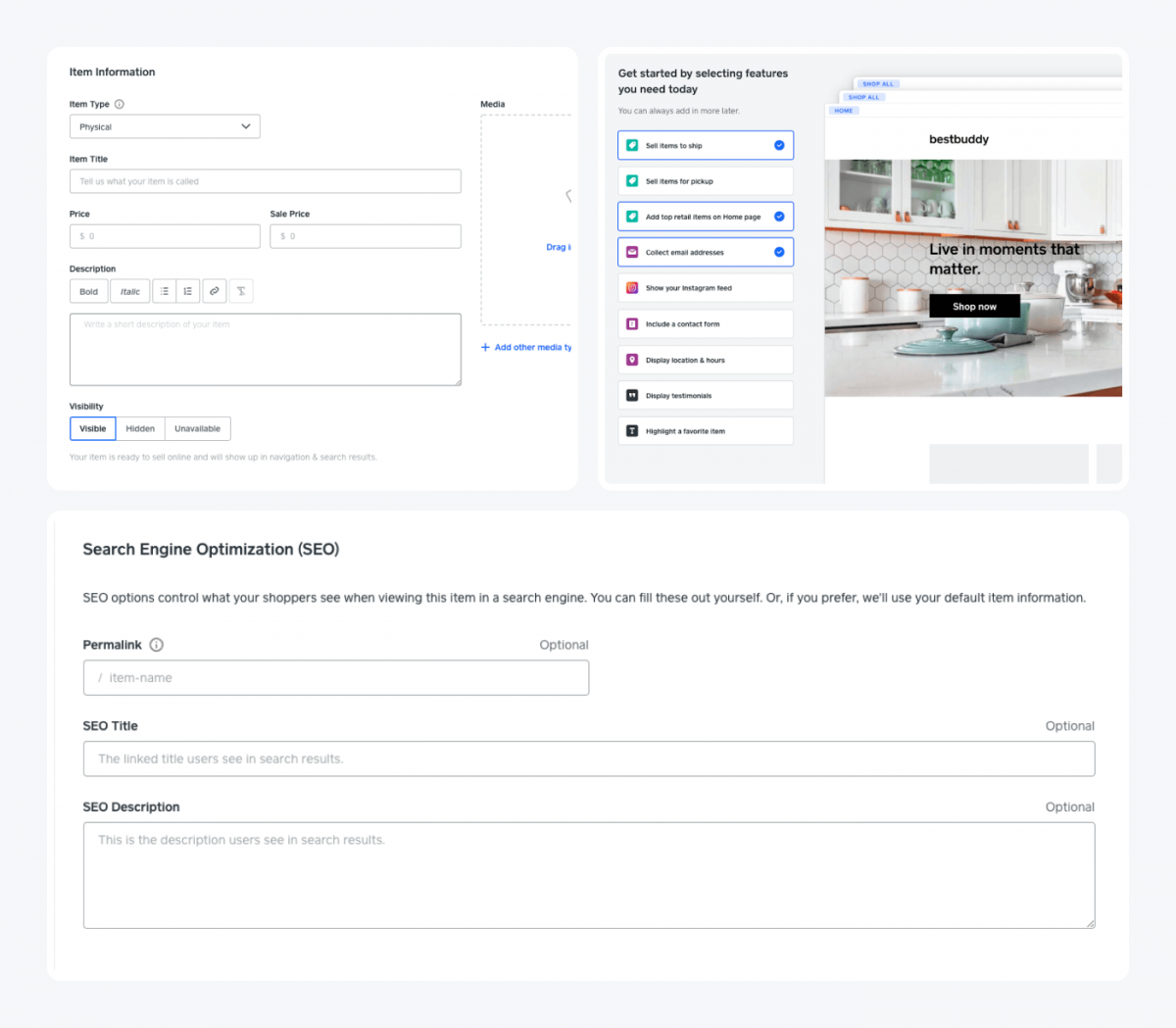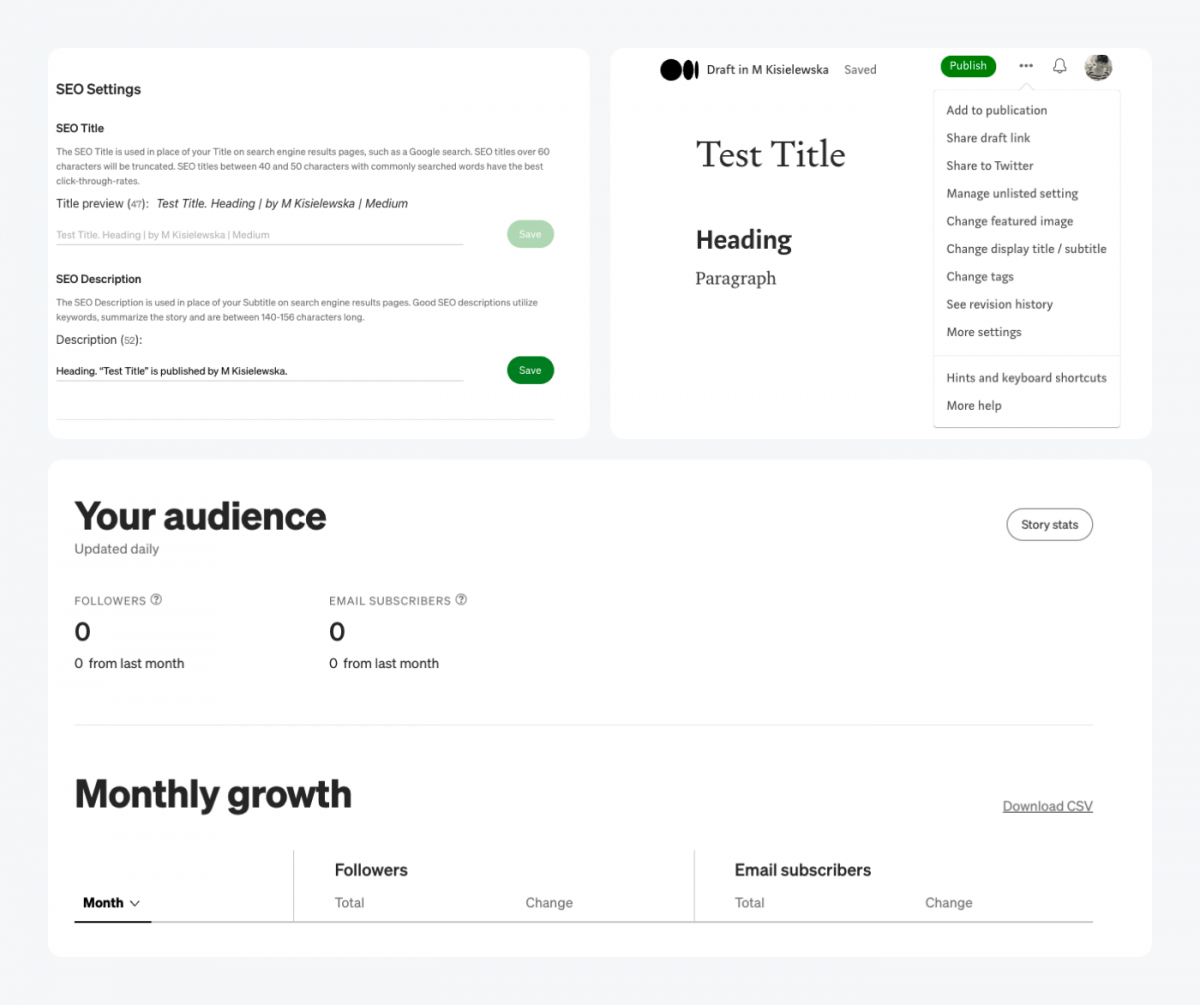Why even consider WordPress alternatives? Well, just look at what dissatisfied users say about WordPress:
“Tragic really.”
“It’s like they hate the user.”
“Some of the code is ancient history.”
“Nightmare to modify, expand, scale, or even maintain.”
If you find the comments relatable, check out the list of WordPress alternatives in this article. I’m sure you’ll find the best solution to meet your needs.
Get a live chat that seamlessly integrates with all CMSs on the market
What are the best WordPress alternatives?
WordPress websites account for 43% of all sites using CMS technologies. They are scalable, search engines love them, and customization options are limitless. No wonder it’s a popular CMS among major players, such as Zoom.us, Salesforce.com, or Grammarly.com.
In comparison, WordPress competitors, like hosted Wix and open source Joomla have only 10% and 2% of the market share, respectively. The numbers show WordPress isn’t going to be dethroned any time soon.
But let’s get real—
WordPress isn’t the best fit for everyone. And there are plenty of arguments for that. For starters:
- You’ll have a hard time using it without coding skills or a budget to hire a developer
- It has the highest number of hacks among CMS platforms, and 90% of vulnerabilities are linked to plugins
- Frequent updates hinder its functionality
The list could go on and on, but to cut a long story short—
There are a couple of alternatives to WordPress you should explore to see which platform meets your needs.
Check out the comparison table below. It gives you a brief overview of the areas to pay attention to when choosing a CMS.
Scroll down to learn more and see detailed reviews of all the WordPress alternatives we’ve included in the table.

1. Drupal
Drupal is probably the most powerful CMS platform. Many developers will find it the best alternative to WordPress. It’s used by diverse brands, agencies, news outlets, and institutions that can afford an in-house team of developers.
Drupal website example
- Check out the Arsenal FC website’s features that take advantage of standard, out-of-the-box Drupal 8 modules (e.g., blocks view module) to increase customer engagement.
Drupal is designed for developers with advanced knowledge of HTML, CSS, and PHP. Even though it has fewer themes and modules than WordPress, it’s still highly customizable and flexible. Due to its technical configuration options, it will take time to complete a project.
You don’t have to reinvent the wheel when it comes to coding on Drupal websites. If you want to add a new feature to Drupal’s site, “there’s a module for that.” Modules are sets of PHP, JavaScript, and/or CSS files and there are about 48,000 of them in the Drupal library.
However, its themes library and the third-party market aren’t as big as WordPress’s.
Why is it one of the best WordPress alternatives?
- Can handle complex security issues with less effort than WordPress (e.g., PCI compliance, database encryption)
- Can handle high-traffic websites and process loads of data
- Nearly limitless content management functionality with modular design
Downsides
- Source tweaking is time-consuming and has a bigger learning curve than WordPress
- Its technicality will be an overkill for standard websites and blogs
Costs:
- Free to use platform
- Domain & hosting costs
- Development team’s salary
You can test the CMS before installing it with the public Drupal demo for free. You just have to follow a link and put a provided user name and password.
Or you can just watch the video below.
2. Joomla
Joomla is another open-source platform CMS and a free WordPress alternative. It’s similar to WordPress in terms of ease of use and as configurable as Drupal. That’s why Joomla and Drupal make great WordPress alternatives for news sites, university and government websites, and corporations.
Joomla website example
- Visit IKEA’s and Harvard University’s websites to see a full range of Joomla capabilities. They use several Joomla extensions to make them accessible, responsive, and multilingual.
Joomla’s been around nearly as long as WordPress. It still remains one of the most popular content management systems around the world. It provides a robust and complex platform that can produce any type of website. For additional features, you can use nearly 6,000 apps.
When comparing WordPress vs. Joomla in terms of their backends, Joomla has more out-of-the-box features, like non-standard content types, user management, multilingual support, and templates.
What makes it a great WordPress alternative?
- Built-in multilingual support to aid global businesses
- Banner management tool to create ad campaigns and track them
- More default types of media files and an option to determine which ones are uploadable
Downsides
- It might have been the main WordPress competitor in the past but since Drupal and other CMS WordPress alternatives, it’s hard to find something differentiating about it
- Site structure modification, content creation, and maintenance requires expert coding know-how
Cost
- Joomla is an open-source platform that is free to use
- You have to pay for registering a domain and a hosting provider
- There may be extra costs for web development and maintenance
You can use a shared demo installation of Joomla to have a feel about its main and admin pages.
Alternatively, there’s a great tutorial video showing beginners how this CMS works.
3. Adobe Commerce (formerly Magento Open Source)
Magento Open Source is a self-hosted, highly configurable platform which makes it a serious WordPress competitor. Go for it if you’ve outgrown the WooCommerce plugin and need an advanced ecommerce website to manage thousands of SKUs and a large volume of visitors.
Adobe Commerce website example
- Adobe Commerce helps Land Rover display multiple stocks (clothing, accessories, travel, etc.) and easily navigate within the categories. Everything from layout to carousel pictures help them define their brand voice.
Adobe Commerce software is free, but you’ll have to pay for hosting and Adobe Commerce extensions. It can get pricey because it needs a lot of server space to run smoothly.
Adobe Commerce powerful dashboard lets you manage multiple stores, use several worldwide shipping providers, and make transactions in multiple countries, languages, currencies. It will easily scale to support large ecommerce stores.
You need at least intermediate web development skills to design your store yourself and it can take time to get used to all Adobe Commerce out-of-the-box features and extensions. Some Adobe Commerce extensions offer functionalities that can be achieved through a settings configuration. So if you lack experience and download unnecessary apps, it will only add extra weight to your store.
Adobe Commerce has a hosted version of the software, called Adobe Commerce. It has more advanced features (even a drag-and-drop builder) and a higher price tag. It’s suitable for enterprises rather than SMBs.
Why is Adobe Commerce a great WordPress alternative?
- More versatile and secure than WordPress and can support your growth over time
- It has robust inventory and order management features thanks to unlimited product attributes
- Great for multi-channel businesses—you can create separate product catalogs for each channel and bulk-upload them
Downsides
- Adobe Commerce software has a steep learning curve
- Like Shopify, it’s not well optimized for purposes other than ecommerce
Cost
- Magento Open Source platform is free to use
- You need to cover hosting and domain name costs
- There are paid add-ons and themes
- Developers fees can be pricey
Why don’t you test-drive this CMS on a Magento installation demo? It’s public and everyone can access it.
Or you can just watch a video of how others use it. Great for beginners.
4. Wix
It’s an ideal WordPress alternative for bloggers, personal projects (e.g., portfolios), and creative agencies. Go for it if adding video backgrounds, scroll effects, and animations to your pages are on top of your list.
Wix website example
- Check out all the scrolling and visual effects on Mariela Mezquita’s portfolio website.
Wix’s users are all about its drag-and-drop editor and 500+ ready-designed templates that let them quickly build a website. You also get access to a setup wizard—a unique artificial design intelligence called Wix ADI.
Wix also lets you skip templates and use HTML and CSS to design your page from scratch. And if you get stuck, you get a dedicated customer support team to help you along the way.
What makes Wix a good WordPress alternative?
- Excellent all-in-one site builder with free reliable web hosting, domain, and SSL security protocols
- Easy to use for beginners and first-time website owners
- SEO tools include Wix SEO Wiz—a step-by-step guide to help you improve site visibility
Downsides
- Wix has limited control of your site
- More expensive than WordPress in the long run
Cost
- Limited free plan available
- Website Plans from $4.50/mo to $24.50/mo
- Business and ecommerce plans from $17/mo to $35/mo
If you’re not familiar with website builders, you can check out the video below and go from a complete beginner to a pro.
If that’s too long, check out the pictures below to see what’s under Wix’s hood.

Read more: Check out the top Wix chatbots and learn how to add one to your website. Also, compare the best Wix live chat apps available on the market
5. Shopify
Shopify isn’t an obvious WordPress competitor unless you want to start an ecommerce business online. Shopify platform will suit small business owners and larger retailers who don’t have much technical know-how.
Shopify website example
- Check out the professional-looking design and products display on Happiness Abscissa.
Shopify is an adaptable website builder. For example, you may be surprised that the Wicklewood website was built by two people without a degree in web design. You can find out more about their journey and how they manage to stay competitive in the market.
The setup and management of an entire store on the Shopify platform is fairly easy. All you need to do is to set up an account and choose one of the 80 ecommerce themes to build posts and pages. Shopify lets you drag and drop different website elements to customize your page.
Unlike the WooCommerce plugin, you don’t have to worry about security issues, manual backups to your website, because Shopify makes sure payments are safe and the software is up to date.
Shopify has a first-party Point of Sale module to let you integrate Shopify tools with your storefront. There are also plenty of third-party apps for Shopify, like Tidio live chat, to extend your shop’s functionality and improve user experience.
Find out more about WooCommerce vs. Shopify comparison if you’re deciding between those two.
Where does Shopify beat WordPress?
- Hosted ecommerce platform with everything you need under one roof to save you time on backups and maintenance
- Advanced marketing and ecommerce features, like reports or abandoned cart recovery
- PCI compliant and fully secure for credit card payment processing
Downsides
- Not the best for other purposes than ecommerce
- Extra transaction fees for not using Shopify Payments
Cost
- Three plans at $29/mo, $79/mo, and $299/mo for building a website
- Shopify Lite at $9/mo for in-person sales and Buy Button
- Shopify Plus for enterprises with custom pricing
Check out the article about Shopify pricing to see how much it costs on a monthly basis.
If you’ve not heard of Shopify before, this video will explain all you need to know in under an hour.
If that’s too long, just take a look at the images below and see if this is something you can work with.

Read more: Discover the best WordPress chatbot plugins with pros, cons, and pricing compared.
6. Squarespace
Squarespace is one of the best WordPress alternatives for beginners. It’s a drag-and-drop website builder similar to Wix. But it has a few unique features that would appeal to local business owners and beginner bloggers.
Squarespace website example
- Check out Blue Dog bar’s beautiful minimal design which helps focus on content and is easy to navigate.
Squarespace has over 100 templates optimized for mobile and user-friendly customization options to build your business website quickly. In comparison with WordPress, it’s much simpler to use. For example, it only has essential SEO tools and little flexibility in terms of web design.
It has a built-in scheduling feature that lets site visitors see your available slots and book appointments. Other features include podcast streaming, newsletter signup templates, and social media sharing options. You can also add a quiz to Squarespace to capture leads and segment them based on their answers.
In the case of Squarespace, some of its advantages can turn into disadvantages. To make it so intuitive to use, Squarespace got rid of some features like auto-save or a module for inserting a table. You may not notice they are missing until you need them.
WordPress vs. Squarespace advantages
- No coding is needed thanks to the WYSIWYG (what you see is what you get) editor with pre-built sections to visualize the results immediately
- Powerful fully-hosted solution with domain name registration, hosting, and support
- Award-winning Squarespace templates to create portfolios, online stores, blogs, event planning, restaurants, and more
Downsides
- Limited plugins or additional modules to extend Squarespace’s functionality
- Difficult to build a complex website because Squarespace only supports a single sub-level of menu options
Cost
- Four pricing plans ranging from $16 to $54/mo
- A custom domain name from $20 to $70/year
- Save up to 30% on annual plans
Check out how Squarespaces’ editor works in this short tutorial.
Or if you’re in a hurry, you can just preview images below to decide if this WordPress alternative is right for you.

7. Ghost
If you’re looking for a blogging platform, you can choose Ghost instead of WordPress. Ghost is a free WordPress alternative designed to simplify online publishing for individual bloggers and online publications.
Ghost website example
- Check out the subscription options on The Browser that aim to monetize the content on the blog.
Ghost is Node.js supported and open-source. You can build a blog website similar to WordPress, but you won’t be hindered by its excessive web development features. It’s tailor-made for new-media creators to publish and share their content. It comes with tools to build a website, send newsletters, and offer paid subscriptions to members.
In comparison with WordPress, Ghost is a cheap, simple, and lightweight CMS. But this simplicity means giving up on most of the flexibility that comes with WordPress. You can self-host Ghost on your own server, computer, or Raspberry Pi to have full control over your production environment.
Why is Ghost a great WordPress alternative for a blog?
- Specialized solution that provides a straightforward blogging experience
- User-friendly interface with all the necessary publishing tools
- Quick media files uploading
Downsides
- Ghost focuses only on content creation and editing
- Not all web hosts will allow you to run it
Cost
- Free version available
- Fully hosted version with four plans (varied number of staff users and features)
- Monthly subscription fee calculated based on users signed up for your site
Check out how to get started with Ghost in this no-fluff video.
If that’s not of interest to you, take a peek at the images of Ghosts’ admin panel.

8. Weebly
Weebly is another hosted solution on our WordPress alternatives list. It takes care of all technical aspects of housing your site. You can build a fully functional website in a day without any coding skills.
Weebly example website
Check out DOUK SNOW’s online store to appreciate its rich visual content and rather simple functionality.
Weebly lets you tell a story by adding dynamic visual elements to your blog. You can add lead capture forms, image slideshows, embed clips, and even customize fonts. Even a beginner can create beautifully customized portfolios and online stores with Weebly’s templates and drag-and-drop editor. Just like with Wix’s.
But this website-building tool is better suited for sites with more content than Wix. That’s because it allows for deeper (unlimited) sub-level navigation and unlimited storage.
All Weebly templates are designed to work on mobile devices. That means you don’t have to rearrange elements on the page once you finish designing the desktop version. It can prove very useful if your website has dozens of pages.
Why is Weebly a good WordPress alternative?
- All templates are mobile-optimized out-of-the-box
- Free custom domain on the $12/mo plan ($20 value)
- In-build ecommerce and business solutions for hassle-free management
Downsides
- Poor backups—you can download the whole site into a zip file but it can’t be uploaded back into the Weebly site or any other service provider
- It’s unavailable in some countries. The exact list is secret but users frequently mention Russia, Ukraine, Turkey, certain regions in the Middle East, West and Central Africa
Cost
- Free ad-supported version
- Three premium plans for websites from $5 to $25
- Three plans for online stores from $12 to $38
Why don’t you see how to build an online store with Weebly step-by-step in this video.
Or quickly preview its dashboard and functionality in the images below.

9. Medium
It’s definitely not one of the traditional WordPress alternatives. But it will appeal to bloggers and writers who want to promote their stories and posts among the existing Medium user-base.
Medium example website
- Check out how The Economist uses Medium to share its longform and multimedia journalism, alongside their news site and print copy. Medium’s look and navigation suit the purpose really well.
Medium is more of a publishing platform than a website-building tool. It can compete with WordPress sites in terms of blogging and building a social network around your content. There’s no software to download and no drag-and-drop builder.
Instead, you can publish your articles on Medium.com. It has a high domain authority and nearly 100 million monthly active users. Readers can follow you and bookmark, share or comment on articles. You can check basic content performance metrics without leaving Medium.
Every blog post has a similar layout: a cover photo, a profile photo, a brief bio, and a list of posts.
But there are no themes or many visual effects to build your personal brand identity. You’ll only get a personalized URL such as “medium.com/user_name” for free and a custom domain if you’re a Medium member.
How is it a great alternative to WordPress?
- Cheaper and easier to use than WordPress.org and even WordPress.com
- Easier to promote content which beginner authors will appreciate
- Quick start and no coding skills needed
Downsides
- The main focus is writing so you won’t find advanced layout customization options
- Not suitable for online retailers or business blogs due to lack of search engine optimization options or add-ons
Cost
- Free for writers (no hosting or domain costs)
- Optional: Medium Membership to unlock reading articles for $50/year or $5/mo
- Partner Program lets writers earn money (based on reading time of Medium members)
If you’re new to Medium, you can find out how it works and how to make money writing from the video below.
Alternatively, you can get a glimpse of Medium’s admin panel in the screenshots below. You can see how simple it is to start publishing.

But if you still decide to go with WordPress then check out this guide on how to use WordPress to build a website.
Key takeaway: what’s better than WordPress?
Hopefully, after reading this comparison of WordPress alternatives, you have picked a couple of favorites to start or replace a project. Here’s what you should remember:
- You can hardly find any free alternatives to WordPress. Even if you decide to use open source software, you will have to stomach some costs, like hosting services.
- If you don’t need a complex website with unique functionality, the WordPress site will be overkill.
- There are plenty of hosted ecommerce solutions available on the market that let you set up an online store without any coding skills.
- If you’re researching WordPress alternatives for developers, there are more secure solutions and better suited for large ecommerce sites than WordPress.
- As a blogger, you can explore less obvious alternatives with functionality similar to WordPresss but requiring less hassle to manage.
There are plenty of options to build your online presence and before you decide which one to use, you should figure out what your goals are.

